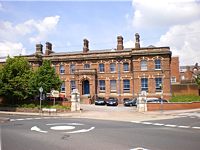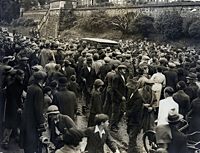
Devon County Prison
Page updated 8th March 2014
Return to Public Services
Situated across the Longbrook valley from Northernhay Castle, the modern Exeter Prison dates from 1853. Before that, the site had been occupied by the Devon County Gaol and Bridewell or House of Corrections.
An Act of Parliament was obtained in 1787 to build a new prison for Devon, outside of the city of Exeter. The Devon Assizes were held in the castle, and up to that time prisoners incarcerated in a prison just outside the castle, but within the city wall, on the site of the Timepiece nightclub.
The County Gaol was built between 1790 and 1794 on a plot of land in St David's of about 8 acres. The building was to a design by William Blackburn, and regarded by Pevsner as 'the most important early prison designer', and held about 100 prisoners. The entrance to the gaol was near the former headquarters of the Devon Constabulary, to the east of the main entrance.
Jenkins in his history of Exeter wrote of the County Gaol:
"The principal part consists of brick, made and burnt on the same spot, with moor-stone copings; the lodge in front, which is of moor-stone copings; the lodge in front, which is of moor-stone, is furnished with baths. The chapel is very neat, and the Gaoler's house commodious, and every necessary accommodation for the health, as well as security, of the prisoners is provided."
Jenkins also described an accident during the construction:
"At the commencement of this building, a melancholy accident happened to one of the labourers employed in sinking the well; after getting to the depth of near thirty feet, the sides, not being properly secured, gave way, and he was crushed to death: some time elapsed before he could be dug out, when a shocking spectacle presented itself to the spectators."
The Bridewell was built in 1807 and held 150 – it was to the west of the County Gaol, and its entrance was where the present main entrance is now situated, Conditions in the Bridewell were tough and prisoners often had to work the treadmill as part of their sentence.
Hayward's 1853 prison
In 1853, the prison at new North Road was rebuilt by the prolific John Hayward, based on the plan of the model prison that had been built at Pentonville. Originally housing 193 cells of 13 ft by 7 ft, the surrounding wall was over 20ft high.
The prison was described in Vincent's Guide to Exeter, 1884 thus:
"The prison is built on the Pentonville, or 'silent' system. Every prisoner has a separate cell, about 13 feet by 7 feet, and contains water, washing bowl, bed, table, stool, &c., and a gas-jet. the cells are well ventilated, and the vitiated air is carried off by an extracting flue. The food to the inmates are delivered through flaps. There is a bell-pull, which strikes upon a gong and throws back a plate with the number of the cell, when the prisoner requires the attendance of a warder, in the case of sickness or otherwise. The exercise yards are arranged into radiating compartments to prevent the prisoners communicating with each other. The officer in charge has an inspection house in the centre, so as to have the whole of the prisoners under his eye whilst taking exercise. The chapel has also radiating seats so contrived that the prisoners are precluded from seeing each other. The superior advantages attending the separate system of prison discipline has caused it to be generally adopted."
The Devon County Police Headquarters was situated in a building on the eastern end of the prison until they moved out to Middlemoor.
A prisoner named Robert Graham who was, in 1903, serving seven years for burglary at Exeter Gaol, managed to remove some bricks in the wall of his cell, while the governor was on holiday. He crawled through, dragging a plank that he had procured from his carpenter's bench. He then used the plank as a ladder to reach the top of the prison wall, climbed onto the roof of the Governor's house, dropped through a skylight and stole a deer-stalking cap and shooting-coat belonging to the Governor, unlocked the shutters and escaped into the street. He was not missed for half an hour, when a man hunt was instigated. After a day and a night, Graham reached Newton Abbot where a vigilant policeman noticed his convicts clothes under the Governor's shooting coat, and he was promptly arrested.
An escape in September 1960 of three men who climbed over a 20ft wall, and stole a green shooting brake from Velwell Road, was reported in the Times. The car belonged to Mr I Bartlett, who was inside his house at the time, having lunch. There was enough petrol for 30 miles and maps in the vehicle to aid the prisoners escape.
Executions see Exeter Executions
The first execution at the County Gaol was of William Martingborough on Friday 20th March 1795. He was convicted of murdering Henry Smith and described at the time by the newspapers as a 'man of colour'.
Jenkins wrote in his history of Exeter of the County Gaol:
On the roof of the lodge, which is flat, and covered with lead, a temporary platform and gallows is erected for the execution of malefactors.
This drop was last used in 1849 when 40,000 watched James Landick hung for murder. After the new prison opened in 1853, executions were held on the flat roof of a stone lodge at the front, on a temporary scaffold. This gave the large crowd, assembled on the slopes of Northernhay Gardens, a fine view of the proceedings. Perhaps the most famous execution at the prison was the one that never happened. They attempted to hang John 'Babbacombe' Lee three times, but each time the trap door jammed. His sentence was commuted to life.
A more recent execution was of an illiterate, 33 year old Irish woman with five children, who was hung at the Prison on 15th July 1936 for poisoning her husband. The anti-capital punishment campaigner Mrs Van de Elst made an appearance in her Rolls Royce at 8am outside the prison in protest, with a crowd of about 2 to 3 thousand. Bryant sent a telegram to King Edward VIII the day before which said "Mighty King, Have pity on your lowly, afflicted subject. Don't let them kill me on Wednesday. Ask them to give Mrs Van de Elst an opportunity of saying what will prove my innocence. From the brink of the cold, dark, grave I am a poor helpless woman. I ask you not to let them kill me, I am innocent." There were three more executions at Exeter Prison, the last in 1943, when the gallows were dismantled and sent to Jersey, where it was used once more in the mid 1950s.
Mrs Pankhurst
Mrs Emmeline Pankhurst was subject to the so called 'cat and mouse' law in 1913, when the authorities would imprison her, and release her when she went on hunger strike, to then arrest her again when she had recovered. On one such occasion, she was arrested on the 4 December 1913, when the Majestic anchored in Cawsands Bay, after she had toured the United States, and brought by car over Dartmoor to be imprisoned at Exeter Prisonl. On the 7 December she was released on seven days licence, and proceeded to the Great Western Hotel where a reporter from the Express and Echo spoke with her. She said she had spent a bad night and was only able to take invalid food. Mrs Pankhurst also spoke of the good treatment she reoeived in the prison. She then left on the 10.15am train to Paddington, accompanied by friends.
New flats were built in 2005 on the Central Station railway yard, destroying a fine view across the Longbrook Valley from Northernhay Park to the front of the prison. It was announced in 2013 that along with Channings Wood and Dartmoor, Exeter prison was to become a 'resettlement' prison, to house prisoners from the locality. Men serving less than 12 months would be imprisoned in their local prison, and receive a “tailored package of supervision and support” on their release.
Source - Reminiscences of Exeter Fifty Years Since by James Cossin, various websites about John Lee. The Law Commission Statute Law Revision - Gaols Repeal Proposals April 2006, JenkinsHistory of Exeter 1805, Western Times and Express and Echo.

When postcards were popular, all public buildings, including prisons were photographed to be sent as a souvenir from home or holiday..
│ Top of Page │






